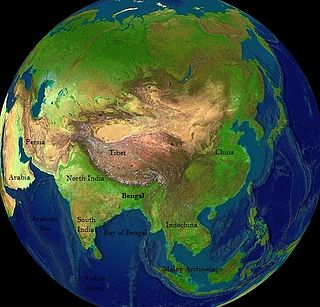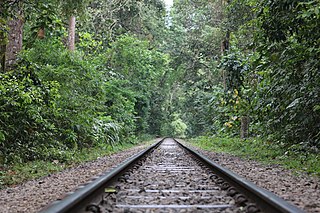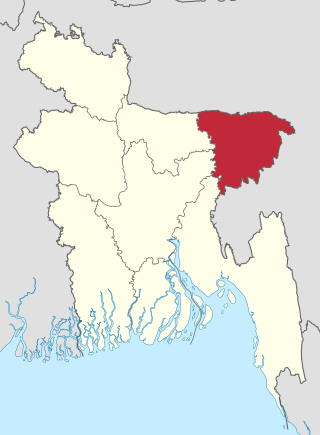
Bengal or endonym Bangla is a historical geographical, ethnolinguistic and cultural term referring to a region in the eastern part of the Indian subcontinent at the apex of the Bay of Bengal. The region of Bengal proper is divided between modern-day Bangladesh and the Indian state of West Bengal. The Indian states of Assam, Jharkhand, Bihar, Chhattishgarh and Tripura as well as the union territory of Andaman and Nicobar islands have a sizeable Bengali population. A large Bengali diaspora exists across the world. Bengali is the sixth-most spoken language in the world.

Dhaka, formerly known as Dacca, is the capital and largest city of Bangladesh. It is the ninth-largest and seventh-most densely populated city in the world. Dhaka is a megacity, and has a population of 10.2 million residents as of 2022, and a population of over 22.4 million residents in Dhaka Metropolitan Area. It is widely considered to be the most densely populated built-up urban area in the world. Dhaka is the most important cultural, economic, and scientific hub of Eastern South Asia, as well as a major Muslim-majority city. Dhaka ranks third in South Asia and 39th in the world in terms of GDP. Lying on the Ganges Delta, it is bounded by the Buriganga, Turag, Dhaleshwari and Shitalakshya rivers. Dhaka is also the largest Bengali-speaking city in the world.

Chittagong, officially Chattogram, is the second-largest city in Bangladesh. Home to the Port of Chittagong, it is the busiest port in Bangladesh and the Bay of Bengal. It is the administrative seat of an eponymous division and district. The city is located on the banks of the Karnaphuli River between the Chittagong Hill Tracts and the Bay of Bengal. The Greater Chittagong Area had a population of more than 5.2 million in 2022. In 2020, the city area had a population of more than 3.9 million. The city is home to many large local businesses and plays an important role in the Bangladeshi economy.

Dhaka Division is an administrative division within Bangladesh. Dhaka serves as the capital city of the Dhaka Division, the Dhaka District and Bangladesh. The division remains a population magnet, covers an area of 20,508.8 km2 with a population in excess of 44 million, It is the most populous country second level division of the world, growing at 1.94% rate since prior count, compared with national average of 1.22%. However, national figures may include data skewing expatriation of male labor force as gender ratio is skewed towards females.

Sylhet Division is the northeastern division of Bangladesh. It is bordered by the Indian states of Meghalaya, Assam and Tripura to the north, east and south respectively, and by the Bangladeshi divisions of Chittagong to the southwest and Dhaka and Mymensingh to the west. Prior to the Partition in 1947, it included Karimganj subdivision. However, Karimganj was inexplicably severed from Sylhet by the Radcliffe Boundary Commission. According to Niharranjan Ray, it was partly due to a plea from a delegation led by Abdul Matlib Mazumdar.

Sandwip is an island located along the southeastern coast of Bangladesh in the Chattogram District. Along with the island of Urir Char, it is part of the Sandwip Upazila.

Bangladeshi cuisine has been shaped by the region's history and river-line geography. Bangladesh has a tropical monsoon climate. The staple of Bangladesh is rice and fish. The majority of Bangladeshi people are ethnic Bengali, accustomed to Bengali cuisine, with a minority of non-Bengalis, many used to cuisines from different traditions and regions. Bangladeshi cooking features more meat dishes than the cuisine of neighbouring West Bengal, India.

The Chittagong Stock Exchange is a stock exchange based in the port city Chittagong, Bangladesh. It is one of the twin financial hubs of the country, alongside the Dhaka Stock Exchange. Established in 1995, the exchange is located in the Agrabad business district in downtown Chittagong. It has a combined market capitalization of over US$ 38 billion as of 2020.

Dhaka (Dacca) is a modern megacity with origins dating to circa the 7th century CE. The history of Dhaka begins with the existence of urbanised settlements that were ruled by the Hindu Gauda Kingdom, Buddhist and Shaivite Pala Empire before passing to the control of the Hindu Sena dynasty in the 10th century CE. After the Sena dynasty, the city was ruled by the Hindu Deva Dynasty.

Sitakunda is an upazila in the Chattogram District of Chattogram Division, Bangladesh. It includes one urban settlement, the Sitakunda Town, and 10 unions. Sitakunda is the home of the country's first eco-park, as well as alternative energy projects, specifically wind energy and geothermal power.

Tourism in Bangladesh includes tourism to World Heritage Sites, historical monuments, resorts, beaches, picnic spots, forests, tribal people, and wildlife of various species. Activities for tourists include angling, water skiing, river cruising, hiking, rowing, yachting, and sea bathing.

The Prithimpassa family, also known as the Nawabs of Longla, are an Shia royal family from the Prithimpassa Union, Kulaura Upazila, Moulvibazar, Sylhet, Bangladesh. The family was of the erstwhile feudal nobility of East Bengal. They played important roles in the Indian Rebellion of 1857, the Partition of India and Sylhet referendum in 1947, and the Bangladesh Liberation War of 1971.

The Akhaura–Kulaura–Chhatak line is a railway line connecting Akhaura and Chhatak, via Kulaura in Bangladesh. This line is under the jurisdiction of Bangladesh Railway
The Akhaura–Laksam–Chittagong line is a railway line connecting Akhaura and Chittagong, via Laksam in Bangladesh. There are branch lines from Laksam to Chandpur and Noakhali. This line is under the jurisdiction of Bangladesh Railway.

The city of Chattogram (Chittagong) is traditionally centred around its seaport which has existed since the 4th century BCE. One of the world's oldest ports with a functional natural harbor for centuries, Chittagong appeared on ancient Greek and Roman maps, including on Ptolemy's world map. Chittagong port is the oldest and largest natural seaport and the busiest port of Bay of Bengal. It was located on the southern branch of the Silk Road. The city was home to the ancient independent Buddhist kingdoms of Bengal like Samatata and Harikela. It later fell under of the rule of the Gupta Empire, the Gauda Kingdom, the Pala Empire, the Chandra Dynasty, the Sena Dynasty and the Deva Dynasty of eastern Bengal. Arab Muslims traded with the port from as early as the 9th century. Historian Lama Taranath is of the view that the Buddhist king Gopichandra had his capital at Chittagong in the 10th century. According to Tibetan tradition, this century marked the birth of Tantric Buddhism in the region. The region has been explored by numerous historic travellers, most notably Ibn Battuta of Morocco who visited in the 14th century. During this time, the region was conquered and incorporated into the independent Sonargaon Sultanate by Fakhruddin Mubarak Shah in 1340 AD. Sultan Ghiyasuddin Azam Shah constructed a highway from Chittagong to Chandpur and ordered the construction of many lavish mosques and tombs. After the defeat of the Sultan of Bengal Ghiyasuddin Mahmud Shah in the hands of Sher Shah Suri in 1538, the Arakanese Kingdom of Mrauk U managed to regain Chittagong. From this time onward, until its conquest by the Mughal Empire, the region was under the control of the Portuguese and the Magh pirates for 128 years.

The economy of Sylhet is the 5th largest in the Peoples Republic of Bangladesh. It has a gross state product of $16 billion in nominal terms, and $40 billion in terms of purchasing power parity, making it the third largest behind Dhaka, Chittagong, Khulna and Rajshahi. Since the formation of Bangladesh, Sylhet has been regarded as the spiritual and cultural center of the country, and often termed as the agricultural capital of Bangladesh. Due to vast natural resources and emerging metropolitan, Sylhet is a major economic hub of the country alongside Dhaka and Chittagong. In recent years, Sylhet is experiencing major infrastructural developments, and projected to be the forefront of Bangladesh's economic growth. Sylhet is known for its tea plantations. About 80% of the country's agar processing factories are located in Barlekha Upazila.

Bangladesh is an important tea-producing country. It is the 12th largest tea producer in the world. Its tea industry dates back to British rule, when the East India Company initiated the tea trade in the hills of the Sylhet region. In addition to that, tea cultivation was introduced to Greater Chittagong in 1840. Today, the country has 166 commercial tea estates, including many of the world's largest working plantations. The industry accounts for 3% of global tea production, and employs more than 4 million people.

Sylhet railway station is a railway station in Bangladesh. There are two types of rail lines in Bangladesh Meter gauge and Broad gauge. This station is connected with meter-gauge link on both sides from Chhatak and Dhaka. This railway station is situated in Sylhet city.

The Greater Sylhet region predominantly included the Sylhet Division in Bangladesh, and Karimganj district in Assam, India. The history of the Sylhet region begins with the existence of expanded commercial centres in the area that is now Sylhet City. Historically known as Srihatta and Shilhatta, it was ruled by the Buddhist and Hindu kingdoms of Harikela and Kamarupa before passing to the control of the Chandra, Sena and Deva dynasties in the early medieval period. After the fall of these Buddhist and Hindu principalities, the region became home to many more independent petty kingdoms such as Jaintia, Gour, Laur, and later Taraf, Pratapgarh, Jagannathpur, Chandrapur and Ita. After the Conquest of Sylhet in the 14th century, the region was absorbed into Shamsuddin Firoz Shah's independent principality based in Lakhnauti, Western Bengal. It was then successively ruled by the Muslim sultanates of Delhi and the Bengal Sultanate before collapsing into Muslim petty kingdoms, mostly ruled by Afghan chieftains, after the fall of the Karrani dynasty in 1576. Described as Bengal's Wild East, the Mughals struggled in defeating the chieftains of Sylhet. After the defeat of Khwaja Usman, their most formidable opponent, the area finally came under Mughal rule in 1612. Sylhet emerged as the Mughals' most significant imperial outpost in the east and its importance remained as such throughout the seventeenth century. After the Mughals, the British Empire ruled the region for over 180 years until the independence of Pakistan and India. There was a complete list of the different amils who governed Sylhet which was recorded in the office of the Qanungoh of Sylhet. However, most complete copies have been lost or destroyed. Dates from letters and seal traces show evidence that the amils were constantly changed. In 1947, when a referendum was held, Sylhet decided to join the Pakistani province of East Bengal. However, when the Radcliffe Line was drawn up, Karimganj district of Barak Valley was given to India by the commission after being pleaded by Abdul Matlib Mazumdar's delegation. Throughout the History of Sylhet, raids and invasions were also common from neighbouring kingdoms as well as tribes such as the Khasis and Kukis.

Mezban, locally known as Mejjan is a popular social festival held in the Chittagong region of Bangladesh. Historically Mezban is a traditional regional feast and by people's recommendation nowadays it sufficiently also means that it's a special kind of recipe which includes the regional tradition specifically but primarily this denotes both the traditional feast and the materializing food that serves the famous Mezbani meal consisting of steamed white rice and hot beef, usually along with other dishes like 'chonar daal' or curry of mung bean and beef fat chunks, 'nolar kanzi' or beef bone marrow soup, and the kala bhuna or dried beef with onions. The feast is held on occasions such as death anniversary, birth anniversary, launching of a new business, the birth of a child, marriage, aqiqah and circumcision, and ear piercing of girls among others. The invitation of the Mezban ceremony generally remains open for all and various people to different places and neighborhoods convey the invitation for the feast. The invitation cards are printed and distributed among the guests only in urban areas. Usually, the consumption of food at Mezbani takes place from morning to afternoon.

















